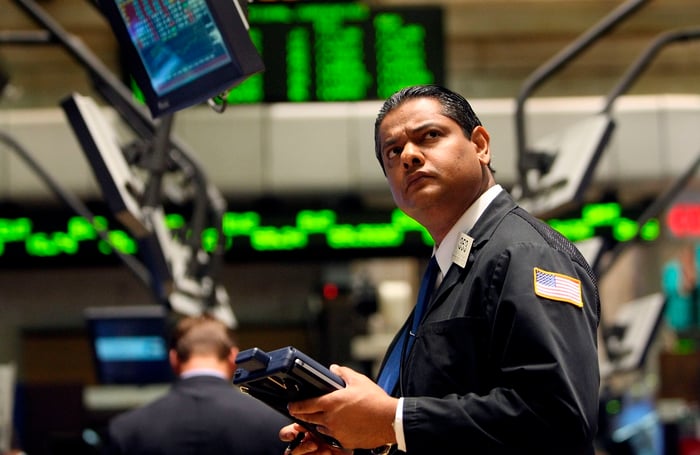Since the beginning of 2025, Wall Street's three primary stock indices have experienced significant volatility.
Immediately following President Donald Trump’s announcement of his tariff and trade strategy after the markets closed on April 2, the broad-market S&P 500 ( ^GSPC 0.49%), the tech-heavy Nasdaq Composite ( ^IXIC 0.72%), and the well-known Dow Jones Industrial Average ( ^DJI 0.37%) all suffered a sharp decline. Both the S&P 500 and Dow slipped into correction territory, while the Nasdaq experienced its first bear market since 2022. The S&P 500 also recorded its fifth-largest two-day percentage loss in the past 75 years.
The narrative changed on April 9, when Trump revealed a 90-day suspension of "reciprocal tariffs" for many nations. That day, the S&P 500, Dow, and Nasdaq Composite each posted the biggest one-day point increases in their histories and have since surged to several new all-time closing highs.
On the surface, things may look ideal for equities and the U.S. economy -- but appearances can be misleading.

Image source: Getty Images.
This forecasting algorithm has an impeccable record for predicting U.S. recessions
At any point, there is always some indicator or past event threatening to pull the main stock indexes lower. For instance, the S&P 500’s Shiller Price-to-Earnings (P/E) Ratio is currently approaching its second-highest level in over 150 years of back-testing. Historically, such elevated valuations have often signaled trouble ahead.
However, an even more ominous predictor has come from Moody's ( MCO -0.14%) Analytics, signaling potential trouble for both the U.S. economy and the stock market.
In July, Moody's Analytics published results from a recently designed model that uses machine learning (ML) to calculate the likelihood of a U.S. recession in the upcoming year. The model incorporates a wide array of economic metrics and back-tests data from 1960 through 2025 to estimate historical recession probabilities.
When looking back to 1960, whenever the recession probability reached or exceeded 50%, a recession eventually (emphasis on eventually!) followed. Moody's ML model highlighted eight separate occasions from 1960 to 2020 where the odds of recession climbed over 50%, and each time, a U.S. recession ensued.
According to Moody's newly introduced leading economic indicator, which uses a machine learning algorithm on our comprehensive databases, there is a concerning 48% chance that the U.S. economy will enter a recession in the next year. This is under 50%,... pic.twitter.com/AGuEJznDzQ
-- Mark Zandi (@Markzandi) September 14, 2025
As seen in the above post on X (formerly Twitter) from Mark Zandi, Moody’s Analytics chief economist, their machine-learning model currently forecasts a 48% risk of a U.S. recession over the coming 12 months. While this is below the 50% level that has always preceded a recession for the last 65 years, any reading significantly above 40% has also been a strong warning sign of a downturn.
Zandi specifically noted that the model has identified building permits as the top economic variable for signaling recessions: "The algorithm has found that building permits are the most significant indicator for anticipating recessions. While permits were relatively resilient, as builders boosted sales with interest rate buydowns and other incentives, inventories of unsold homes are now high and increasing."
Permit activity for homes has dropped back to its lowest point since the peak of the pandemic.
Though the S&P 500, Dow Jones Industrial Average, and Nasdaq Composite are not perfectly correlated with the broader U.S. economy, a recession would probably lead to lower corporate profits. Given the S&P 500’s already stretched Shiller P/E, it may not take much to spark a correction—or something worse—in the stock market.

Image source: Getty Images.
Wall Street’s latest algorithm pales in comparison to historic trends
While the forecast above may seem discouraging—especially in light of Moody’s new model’s perfect performance over the past 65 years—it still doesn’t match the weight of historical patterns that go back even further.
To be clear, recessions are a normal and unavoidable part of the economic cycle. No degree of optimism or policy tweaks can entirely stop these downturns from occurring from time to time.
Even if the Moody’s Analytics model doesn’t perfectly predict a recession within the next year, the odds are relatively high that one will occur in the near future.
But the other side is just as critical: Recessions tend to be brief. Since World War II ended, the average recession has only lasted about 10 months, with none extending beyond 18 months.
By contrast, economic expansions in the past eight decades have averaged five years, with two cycles surpassing ten years. These much longer upswings are what drive the long-term growth of the U.S. economy and corporate profits.
This pattern of uneven growth and contraction is mirrored in stock market returns.
^SPX data by YCharts . S&P 500 return from Jan. 3, 1950-Sept. 16, 2025.
Data shared on X by Bespoke Investment Group in June 2023 highlighted a pronounced contrast between the durations of S&P 500 bull and bear markets. Since the onset of the Great Depression in 1929, bear markets have typically lasted just 286 days (less than 10 months), while bull markets have averaged 1,011 days (about two years and nine months).
Looking even further back, the pattern remains consistent.
Crestmont Research analysts examined the rolling 20-year total returns, including dividends, of the S&P 500 going back to 1900. Though the S&P wasn’t formally created until 1923, researchers reconstructed returns using its components from other major indexes as far back as 1900 to build a total return series.
Their research revealed that all 106 rolling 20-year periods delivered positive annualized total returns. In other words, if someone had purchased an S&P 500-tracking index at any time from 1900 through 2005 and simply held it for 20 years, they would have realized a profit. Regardless of recessions, depressions, wars, pandemics, or other crises, the S&P 500 has always ended up higher, on a total return basis, over any 20-year span since 1900.
So, even if Moody’s latest machine learning model is spot-on, long-term investors have little reason to worry.